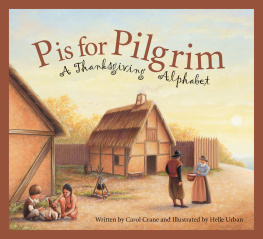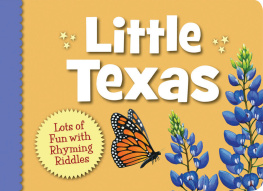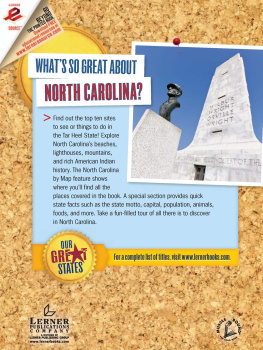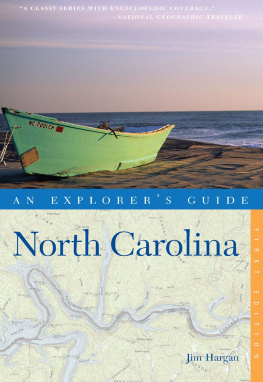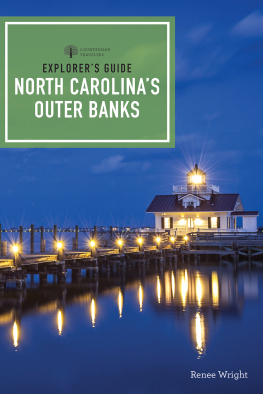T is for Tar Heel
A North Carolina Alphabet

Written by Carol Crane and Illustrated by Gary Palmer

To Sharon Marble, a native Tar Heel, educator, and friend.
CAROL CRANE
To my wife, Rebecca, for her love and support,
and to my sons, Joel and Evan, for their friendship and inspiration.
GARY PALMER
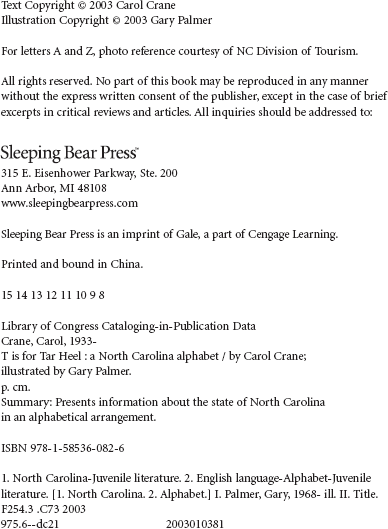
A
The Appalachian Mountains lie within the western North Carolina border. It is one of the oldest mountain ranges in the world. Along the border of North Carolina and Tennessee lie the Great Smoky Mountains. The Blue Ridge Mountains are the eastern mountain range. Emeralds, rubies, garnets, amethyst, and sapphires are found here. The emerald is the official state precious stone, while the official state rock is granite.
In North America, only the forests of the great Northwest receive more rainfall than the Appalachians. The pine tree is the official state tree. There are also black bears, rattlesnakes, hawks, and other wildlife to see. The gray squirrel is the official state mammal.
Rain and downhill mountain terrain have developed 250 spectacular waterfalls. Whitewater Falls is the highest waterfall in the eastern United States. Visitors can slide like playful otters down Sliding Rock Waterfall. This natural 60foot slide drops you into a cold pool below. What fun!
A is for the Appalachian Mountains, trees, trails, animals, birds, and flowers.
Natures green and noble heights, welcome us in sun and showers.

B
In 1771 a German historian and scientist reported seeing the mysterious lights on Brown Mountain. The U.S. Geological Survey has investigated these lights. One thing is certain, the lights do exist. The lights show up on the horizon appearing to be the size of a star. Sometimes they have a reddish or blue cast. The lights move near, fade away, and then reappear. On dark nights they pop up so thick and fast its impossible to count them.
Early frontiersmen believed the lights were the spirits of Cherokee and Catawba warriors. Many North Carolina families head for the mountain at night, waiting to see this awesome sight that no one can explain.
B stands for Brown Mountain Lights, mysterious star-shaped eerie glow.
Forever moving with a blaze and shimmer, some say its ghosts from long ago.

C
The Cape Hatteras Lighthouse has warned sailors of dangerous shallow sandbars off the Atlantic Ocean coast for more than 100 years. The Diamond Shoals extend 14 miles out into the Atlantic Ocean. The area along the Outer Banks is called the Graveyard of the Atlantic. Over 2,000 ships have run aground or been lost along this strip of the sea. The lighthouse has spiral striping and has the nickname The Big Barber Pole. Its beacon of light can be seen 20 miles out at sea. The keeper of the lighthouse had to climb 268 steps to light the lamp.
Whale oil was used to keep the light burning. Today, the light is kept burning by electricity and is not cared for by a lighthouse family. Six lighthouses along the North Carolina coast help sailors get their bearings at sea. Each lighthouse has a different light pattern sending its beacon of light, and each has a different painted design.
C is for the Cape Hatteras Lighthouse, sending a light with great power.
Signaling all ships at sea, ever vigilant hour by hour.

D
The flowering dogwood is the official state flower of North Carolina. Everyone knows spring has finally arrived when the dogwood is in bloom. Many of the blooms have a pink blush while others are pure white. In the center are berries that turn a bright red in the fall. What a sight to see the official state bird, the cardinal, sitting and singing among the abundant flowers in the spring and feasting on the red berries in the fall!
Now, D is for the Dogwood, flowers gentle pink and white.
From mountains to city streets, in spring a showy delight.

E
With a high domed shell and streaks, spots, and lines of yellow and orange, the Eastern Box Turtle is a familiar sight throughout North Carolina. The turtle pulls in his legs and head and closes his shell like a box. This is a cozy house he can escape into when in danger. The mother turtle lays three to six eggs in a warm, dark place and leaves them to hatch on their own. The babies are so small and have none of the bright colors of the adult turtles, so they are hard to see. Box turtles often live 30 to 40 years. Eastern Box Turtles keep our ponds and streams clean. We must protect these reptiles that help our states environment.
The letter E is for the Eastern Box Turtle, official reptile of our state.
Moving about with a house on his back, he doesnt care if hes late!

F
Carl Sandburg was one of Americas great poets and biographers. He won the Pulitzer Prize for his biography of Abraham Lincoln. He also wrote humorous stories for children. Today his home, Connemara, is a National Historic Site. He lived with his family in this house on the hill for 22 years.
When you enter the house, you see bookshelves in every room, with over 10,000 titles on display. Mr. Sandburg was a great reader of other authors books. Mrs. Sandburg raised prize goats. The National Park Service still maintains the barns and a herd of goats for children to pet. Every summer, in an outdoor theater, students act out his Rootabaga Stories for all to enjoy.
Now, F stands for Flat Rock, here Rootabaga Stories are told.
The home of Americas writer, Carl Sandburg, sit and listen to the tales unfold.

G
The first settlers that came to the valleys of the Blue Ridge Mountains named the mountain for the giant bearded man they saw outlined in its ridges. The Cherokee Indians named the mountain Tanawha for the golden eagles that rode the wind currents.
Grandfather Mountain is the highest peak in the Blue Ridge. It is also the only private park in the world that has been named by the United Nations as an International Biosphere Reserve. People from all over the world visit this unique mountain. Here they may see rare and endangered species such as the peregrine falcon, Blue Ridge goldenrod, funnelweb tarantulas, ravens, and the Virginia big-eared bat.



